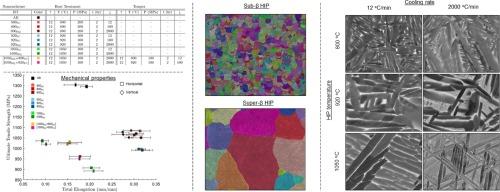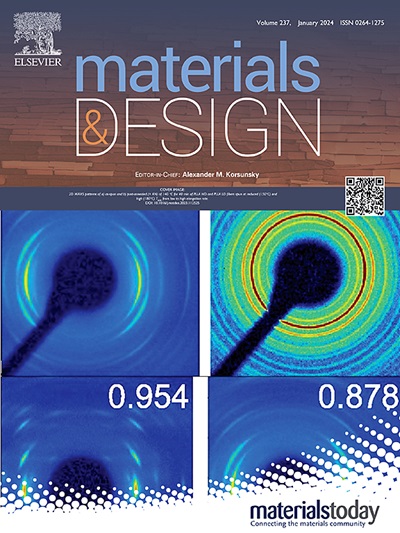Microstructure and mechanical properties of laser powder bed fusion Ti-6Al-4V after HIP treatments with varied temperatures and cooling rates
IF 7.6
2区 材料科学
Q1 MATERIALS SCIENCE, MULTIDISCIPLINARY
引用次数: 0
Abstract
This work investigated non-standard HIP cycles for PBF-L Ti-6Al-4V and characterized microstructure and tensile properties to compare between material that originated from the same build. For 920 °C, faster cooling rates (100 °C/min, 2000 °C/min) were found to promote bi-lamellar α microstructure, while the 2000 °C/min cooling rate improved the strength. For HIP with lower temperature (800 °C, 200 MPa), coarsening was minimized resulting in strength improvement. The slow cooling rate (12 °C/min) showed the highest strength as faster rates increased the amount of orthorhombic martensite (). For HIP with higher temperature (1050 °C), the as-built crystallographic texture was reduced and equiaxed prior-β grain morphology resulted, leading to more isotropic tensile properties. However, the cooling rate (2000 °C/min) was not enough to prevent formation of grain boundary α, which reduced strength and elongation. Machine learning was carried out on the dataset via Principal Component Analysis (PCA) to reduce the dimensionality of the parameters and microstructural features.

不同温度和冷却速率的 HIP 处理后激光粉末床熔融 Ti-6Al-4V 的微观结构和力学性能
本研究对 PBF-L Ti-6Al-4V 的非标准 HIP 循环进行了调查,并对微观结构和拉伸性能进行了表征,以便对源自相同构建的材料进行比较。研究发现,在 920 ℃ 时,较快的冷却速率(100 ℃/分钟、2000 ℃/分钟)可促进双层 α 显微结构,而 2000 ℃/分钟的冷却速率可提高强度。对于温度较低(800 °C,200 兆帕)的 HIP,粗化程度最小,从而提高了强度。由于较快的冷却速度会增加正方马氏体(α″)的数量,因此较慢的冷却速度(12 °C/分钟)显示出最高的强度。对于温度较高(1050 °C)的 HIP,坯体结晶纹理减少,形成等轴先β晶粒形态,从而获得更多各向同性的拉伸性能。然而,冷却速度(2000 ℃/分钟)不足以阻止晶界 α 的形成,从而降低了强度和伸长率。通过主成分分析(PCA)对数据集进行了机器学习,以降低参数和微观结构特征的维度。
本文章由计算机程序翻译,如有差异,请以英文原文为准。
求助全文
约1分钟内获得全文
求助全文
来源期刊

Materials & Design
Engineering-Mechanical Engineering
CiteScore
14.30
自引率
7.10%
发文量
1028
审稿时长
85 days
期刊介绍:
Materials and Design is a multi-disciplinary journal that publishes original research reports, review articles, and express communications. The journal focuses on studying the structure and properties of inorganic and organic materials, advancements in synthesis, processing, characterization, and testing, the design of materials and engineering systems, and their applications in technology. It aims to bring together various aspects of materials science, engineering, physics, and chemistry.
The journal explores themes ranging from materials to design and aims to reveal the connections between natural and artificial materials, as well as experiment and modeling. Manuscripts submitted to Materials and Design should contain elements of discovery and surprise, as they often contribute new insights into the architecture and function of matter.
 求助内容:
求助内容: 应助结果提醒方式:
应助结果提醒方式:


